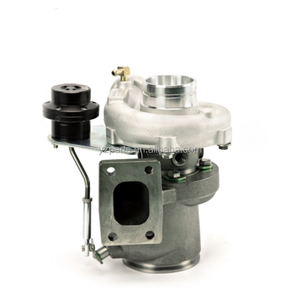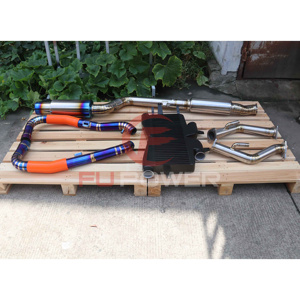(204884 products available)
























































































































































Turbos with, also known as turbochargers, are mechanical devices used to boost the performance of an internal combustion engine by increasing the air intake into the combustion chamber. This allows for more fuel to be injected into the chamber, resulting in a more powerful combustion reaction. There are two main types of turbochargers:
Single Turbo:
A single turbo setup employs a single turbocharger to compress the intake air for an internal combustion engine. This is the most conventional and straightforward type of turbocharged system. Single turbos can vary in size, with larger ones providing more power but slower spool times. Depending on the size of the single turbo, one may experience turbo lag, which is a delay in the turbo kicking in and providing boost. Single turbos are often further categorized based on their size. Single small turbos are quick to spool and provide boost at lower RPMs. This results in a flat torque curve that is ideal for everyday driving. On the other hand, large single turbos produce a lot of boost and are more efficient. However, they take longer to spool and only provide boost at higher RPMs. For this reason, large single turbos are more commonly used in racing applications.
Twin Turbo:
Twin turbo setups utilize two turbochargers to compress the intake air for an internal combustion engine. This can be achieved in a couple of ways: using two identical turbochargers (known as parallel twin turbos) or using two differently sized turbochargers (known as sequential twin turbos). Parallel twin-turbo systems provide even and smooth power distribution throughout the RPM range. They can also improve throttle response and reduce turbo lag. It's worth noting that the twin turbo setup is more complex than the single turbo setup. As a result, they require more maintenance. Despite this, twin turbos significantly enhance engine performance and are, therefore, ideal for high-speed vehicles.
Specifications of turbo with parts are critical for understanding how to choose the proper replacement parts for each specific application. Here are the essential specification factors:
Proper maintenance of turbo with components is vital for extending their lifespan and ensuring reliable performance. Here are some essential maintenance tips:
Choosing a turbo with the right specification for a vehicle involves understanding the car's needs and the turbo's capabilities. Here are some key factors to consider:
Engine Displacement and Configuration
Selecting a turbocharger that complements the car's engine is vital. For instance, vehicles with larger engines (V6 or V8) can handle more airflow than those with smaller (4-cylinder) setups. A 4-cylinder engine might necessitate a smaller turbo to avoid lag, while a larger engine could utilize a bigger turbo without experiencing a significant delay in power delivery.
Power Goals
Consider the desired power output. If only a modest increase is needed, a smaller, more efficient turbo is adequate. However, for substantial power gains, a larger turbo is required. Balancing the turbo size with the expected power level is crucial for achieving a smooth and reliable performance boost.
Fuel Type
High-octane fuels (like 91 or 93 RON) are suitable for use with high-tuning, larger turbos, and custom maps. If the vehicle runs on lower-grade fuel, a smaller turbo is advisable to prevent knocking and ensure reliable operation.
Driving Style and Usage
Aggressive drivers or those who frequently tow/haul should opt for a turbo that provides strong low-end torque and quick spool times. In contrast, casual drivers, especially those in urban settings, might prefer a more balanced setup leaning toward efficiency.
Aftermarket vs. OEM Turbos
OEM turbos are designed precisely for a given vehicle, ensuring perfect fitment and operation. Aftermarket turbos offer a broader range of sizes and potentially higher performance but may require additional modifications to the exhaust, intake, and engine management systems.
Consider Lag and Spool Time
Turbochargers can vary in spool time. It's essential to think about how quickly the turbo will kick in and the effect lag can have on driving experience. For those who prioritize immediate power response, a turbo with lower lag is crucial.
Warranty and Reliability
OEM turbos generally maintain the vehicle's warranty. If warranty coverage is vital, sticking with the original turbo is wise. Researching the reliability of aftermarket turbos and brands is critical if considering a turbo upgrade or replacement beyond the factory specs.
Replacing a turbo with a vehicle can be a complex task that requires a good understanding of automotive mechanics. Here is a general guide on how to replace a turbocharger:
Tools and materials needed:
Steps:
It's always a good idea to consult the vehicle's service manual for specific instructions and torque specifications for each component. If unsure, it's best to have a professional mechanic replace the turbocharger.
Q1: How long does a turbo last?
A1: The longevity of the turbo depends on various factors, including driving habits, maintenance, and the type of engine. Generally, a well-maintained turbo can last between 100,000 to 200,000 miles. However, signs of turbo wear are reduced acceleration, increased exhaust smoke, and the Check Engine light. These symptoms can indicate turbo failure or reduced efficiency, which can affect the vehicle's performance and fuel efficiency.
Q2: What causes turbo failure?
A2: Turbo failure can be caused by several factors, including oil starvation, oil contamination, foreign object damage, heat soak, and excessive mileage or wear. Oil contamination can result from oil sludge, which can be caused by low oil changes or high oil levels. Oil contamination can damage the turbo bearings and lead to turbo failure. Heat soak can damage the turbocharger by overheating it, leading to reduced performance and increased emissions.
Q3: Can a turbo be repaired?
A3: Yes, a turbo can be repaired. However, in some cases, replacement may be more cost-effective and reliable. Rebuilding a turbo involves disassembling the turbo, cleaning and inspecting all parts, replacing worn or damaged components, and reassembling the turbo. Rebuilding a turbo can be a complex and delicate process that requires expertise and experience.
Q4: Can a turbo be fitted to any car?
A4: In theory, a turbo can be fitted to any car. However, the process requires significant modifications, and the car's engine and exhaust system must be compatible with the turbo. Moreover, the turbo must be correctly sized and tuned for the engine to avoid problems like turbo lag or excessive boost pressure.
Q5: Does a turbo require maintenance?
A5: Yes, a turbo requires maintenance to ensure its longevity and performance. Maintaining a turbo is crucial for optimal vehicle performance and longevity. Key components that require maintenance include the turbocharger itself, the intercooler, and the wastegate. Regular oil changes, using high-quality oil, and monitoring the oil level can help prevent oil contamination and ensure proper lubrication of the turbo.